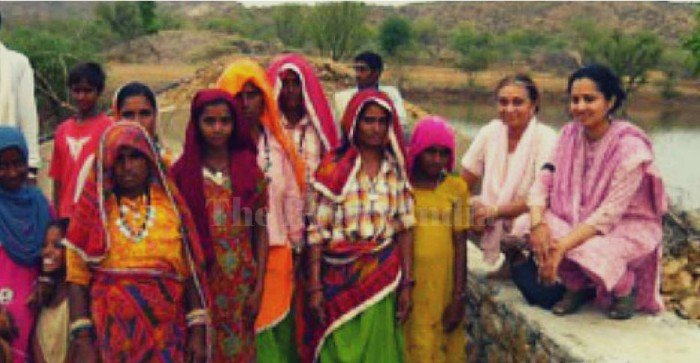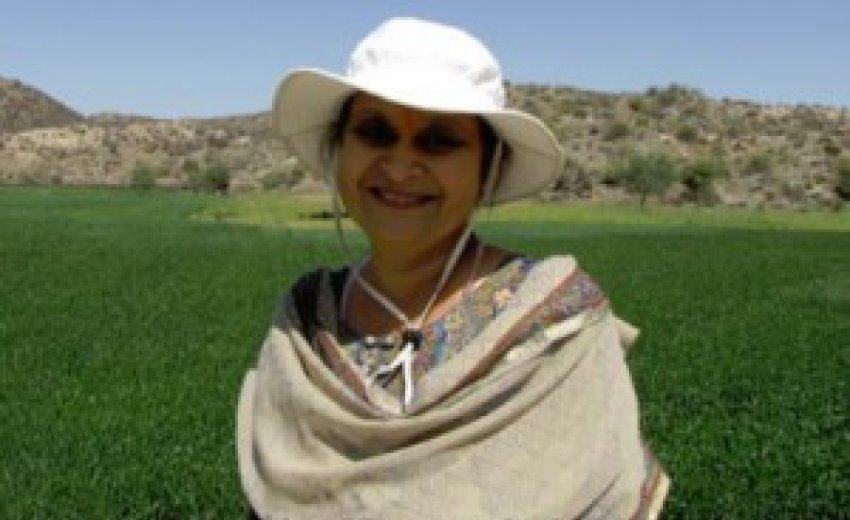December 15, 2015: Amla Ruia has transformed the face of over 100 villages in Rajasthan by using traditional water harvesting techniques and building check dams. This is the story of how she made it all possible by engaging the local community and generating an income of Rs. 300 crores per annum for 2 lakh villagers.
It is not unusual to see dry and deserted farms in Rajasthan, a land known for its scorching summers, parched soil and lack of sufficient water to sustain normal life. But there are some villages where water is no longer a problem, farmers are growing not one but three crops a year, and households are even earning additional income from animal husbandry!
Meet Amla Ruia, the ‘water mother’, who made this amazing story possible.
 |
|
Amla Ruia Photo: Wikipedia |
In 1999/2000, when Rajasthan was going through a severe drought, Mumbai-based social activist Amla read about the poor condition of the farmers there. The photographs in the newspapers and the images she saw on television moved her.
“I saw the government providing water tankers to meet the water needs of the villagers. But I thought to myself that this was not a sustainable solution…there must be a more permanent solution that could help the farmers in the long run,” she recalls.
Amla founded Aakar Charitable Trust to translate her thoughts into action and started researching the water troubles of Rajasthan.
“Rajasthan farmers are among the poorest in the country. Using rain water harvesting technology to alleviate the situation seemed like a good choice. It was important to involve the local community and engage them to make our model more sustainable,” she says.
Amla started her work by constructing check dams near the villages. Check dams, also known as khadin, are structures that involve comparatively small masonry constructions and extensive earthen bunds. They are most effective in hilly terrain where the whole hill range can be used as catchment for the reservoir. They have all the advantages of the large dams and none of the disadvantages, such as displacement and rehabilitation of people, huge underutilized dead storage of water, water logging, risk of breach causing extensive damage to life and property, etc. They are also cost effective.
Her first project in Mandawar village showed great success and the farmers managed to earn as much as Rs. 12 crore within a year with the help of two check dams constructed by the Trust. After that, there was no looking back.
Today, Aakar Charitable Trust has constructed 200 check dams in 100 villages of Rajasthan, and impacted over 2 lakh people who earn a combined income of Rs. 300 crore per year.
 |
| The Aakar Charitable Trust constructed check dams in the villages to solve their water problems. |
ACT works by getting the community on board for each and every project. Almost 40 percent of the cost of construction is borne by the farmers. The construction of one check dam costs around Rs. 5 lakhs and can increase depending upon the size of the dam.
“We were sure that the projects would be successful only if the farmers contributed. We involved the farmers at every step, from sharing the cost to construction and even maintenance. This is how they get a sense of ownership,” she says.
The process of construction of a check dam starts with ACT’s field workers contacting the villagers and spreading awareness about the benefits of water harvesting. Then, some time is spent on deciding on the appropriate location for the dam after consulting with the locals and experts. The villagers then contribute with money and effort. The construction of a check dam takes two to three months and it is usually ready to be used by the next monsoon.
Thanks to Amla’s intervention, dry villages in Rajasthan have seen a tremendous transformation. All the dry hand pumps and borewells in the areas have been recharged. The women who had to earlier walk several kilometres to fetch water now get clean water at their doorsteps.
 |
| The construction of a check dam takes two to three months and it is ready to be used by the next monsoon. |
The water from the dam is sufficient to irrigate crops for the entire year. The farmers, who could barely grow one crop a year, are now able to grow even three crops in a year. “For the first time, villagers managed to grow rabi. They also manage to grow vegetables now,” she adds.
As the income has increased due to better harvests, farmers have started animal husbandry as well. Many households have 8 to 10 cattle head and income from milk, ghee and khoa. Increased income has often provided 1 to 2 motorbikes per family and 4-5 tractors per village.
“There is less migration to the cities now. Earlier, no one was ready to get their daughters married to the men living in these dry villages. That is not a problem anymore,” says Amla.
It wasn’t easy to achieve these results. Many villagers would often back out of their commitments in the middle of the construction of check dams and ACT had to bear the majority of the costs. Many times, government intervention also created hurdles in the operations. But the team kept going despite these challenges.
 |
| The women don’t have to walk several kilometres now to collect water. |
In the future, Amla and her team want to expand their efforts to other states as well. Much work has already been accomplished in Madhya Pradesh and Maharashtra. The organisation is now working in the backward Dantevada district of Chhattisgarh.
To know more about the work of the Aakar Charitable Trust, check out their website.
